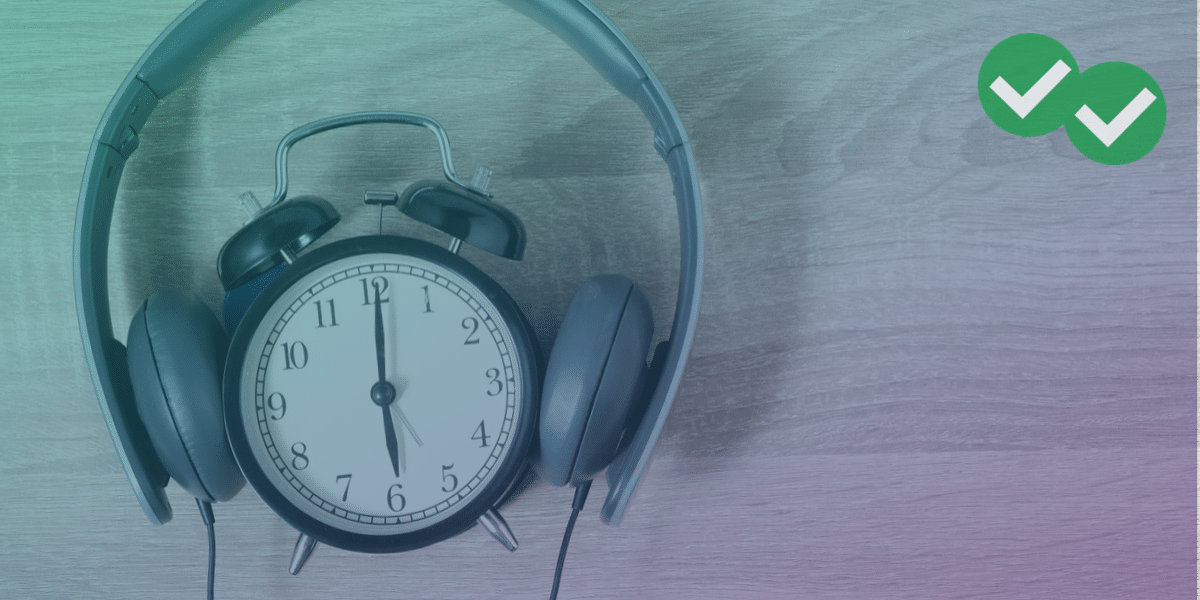
Welcome to Magoosh’s complete guide to TOEFL Listening. Here you’ll get an overview of the listening section of the TOEFL iBT, a look at the different types of questions, and a TOEFL Listening practice test. In addition to that mock test, you’ll get additional practice and tips for Listening on the TOEFL test.
The Structure of the TOEFL Listening Section
TOEFL Listening Question Types
Structure of the TOEFL Listening Section
The Relationship Between TOEFL Listening Lectures, Conversations, and Questions
The Listening section is made up of three to four academic lectures (each accompanied by six questions) and two or three conversations that focus on university life in the United States (each accompanied by five questions). Depending on whether you have an experimental section with some additional unscored experimental questions, the entire section will last either 41 or 57 minutes. Below are the overall stats for the TOEFL Listening audio tracks and question sets.
(NOTE: The timer runs only while you are answering questions and stops when audio is playing; this is why the timer gives only 35 seconds per question.)
| Type of audio | Tracks and questions | Timing |
|---|---|---|
| Lecture | 3-4 tracks 6 Qs per track |
35 sec. per question |
| Conversation | 2-3 tracks 5 Qs per track |
35 sec. per question |
| Both types (standard section) | 5 tracks 28 questions |
41 min. total |
| Both types (experimental section) | 7 tracks 39 questions |
57 min. total |
You will not know the questions while you listen, and you will not be able to listen again to the full recording to check your answer choice. That means a good memory and good notes are key to giving the correct answer. (This is just as important as your listening skills!) You cannot change your answers after they are submitted—your only choice is to answer questions and go forward to the next questions. Sometimes, questions will deal with particular parts of the audio recordings, and the test will replay a small audio clip for you. This is only for certain questions however, usually 0-2 per recording. After a set of five or six questions is finished, the next recording will start automatically.
Subject Matter and Tone: TOEFL Listening vs. TOEFL Reading
The lectures in TOEFL Listening can come from any academic discipline that can show up on the Reading section—in short, almost anything a freshman could take a class in, except math or mathematical sciences. The conversations are either conversations between a student and a professor during office hours, or conversations between a student and some member of support staff/university administration. Often the second kind of conversation deals with topics like course registration, graduation requirements, and financial aid. It helps to become familiar with the language and structure of university administration so you don’t get stuck on a Listening passage that takes place in a setting you’re unfamiliar with, such as, say, a registrar’s office.
Whereas the Reading section features very sterile, academic language, the Listening section is designed to mimic natural speech. This means that the speakers will pause, change sentences or topics abruptly, and occasionally say something incorrect or forget what they were talking about. You may be asked questions about these imperfections, so a familiarity with unrehearsed speech is essential to doing well in the Listening section. Unlike in the Official Guide, no part of the real Listening test will ever be transcribed for you. It’s important to do plenty of Listening practice questions (like the ones found here) without looking at the transcripts!
Many of the question types on the Listening section will look familiar to test takers who have seen the Reading section, but a few will deal with the unique ability of speech to convey information without words—through intonation and stress, for example. In a separate post, we take a more in-depth look at the type of questions that you’ll encounter on the Listening section.
The Listening section will expose you to a variety of content both academic and non-academic. Even before the recording starts, your test will give you some idea of what kind of recording you’ll be listening to, which can help you to know what kinds of questions to expect.
Although all Listening excerpts are noticeably slower than natural speech, the speakers try to speak as naturally as possible. This means that they use all the “ums,” pauses, and sudden redirects that you would encounter in actual language. Not only do you need to be able to navigate these incidental cues, but you also need to be ready to comment on how they function in context, as you will probably have to answer at least one question on your test about the meaning of a byte of incidental language. Needless to say, pacing is key.
Types of TOEFL Listening Audio Clips
As I mentioned above, there are two basic types of TOEFL Listening audio tracks: lectures and conversations. Below, we’ll look at those track types in greater detail, with links to examples of each kind of track. (The examples are all taken from Magoosh’s TOEFL prep service.)
Lectures
The first, and in many ways most grueling, type of Listening assignment is the lecture. Lectures generally last about five minutes, and can be on a wide variety of topics including natural sciences, history, art, anthropology, and business/economics. Each lecture will begin with a sentence like this example: “Listen to the following excerpt from a lecture in an introductory economics class.”
There are two basic types of lecture: with students’ questions and without students’ questions. When there are questions, it may be just one quick interruption or it could be a back-and-forth between the professor and multiple students, in a format similar to a conversation. In either case, the content is the same: all lectures focus entirely on an academic topic and are set in a classroom.
Every lecture is accompanied by six questions, and they may be of any type. You will usually only see organization questions in lectures, so pay extra attention to the organization of any lecture you’re given. (Organization questions focus on the way spoken information is organized, as you’ll learn in this post’s section on TOEFL Listening question types.)
Conversations
The conversation samples are shorter than the lectures, and they may contain academic or non-academic content. They generally take place either between a student and a professor or between a student and someone in a support role at a university. Conversations with a professor may include topics like assignment deadlines (non-academic content), clarification of course material (academic content), or upcoming assignments/projects (can be academic or non-academic content). Conversations with people in support roles include topics like registration, housing, and other logistical aspects of college life. Some familiarity with the language and culture of American higher education will be helpful in understanding the conversations.
Conversations usually last between three and five minutes, and are accompanied by five questions. Conversations are less likely than lectures to have organization or detail questions, but you should expect more questions about attitude and function.
Sample TOEFL Listening Audio Tracks
- Sample Lecture (monologue)
- Sample Lecture (classroom discussion with student questions)
- Sample Conversation
Question Types for TOEFL Listening
There are 7 general question types in TOEFL Listening:
- Detail (understanding specific pieces of factual information)
- Main Idea (identifying the primary purpose of a conversation or lecture)
- Inference (recognizing implied information)
- Organization (recognizing the relationship between different pieces of information; almost exclusively used for lectures)
- Attitude (inferring the speaker’s attitude or opinion)
- Function (understanding the reason a specific thing is said)
- Categorizing (organizing ideas from the audio into categories based on their similarities and differences)
Each of these types deserves careful attention. It’s important to be aware of how every question type works. As you practice for TOEFL Listening, you should also become aware of which question types you fee lmost confident in, and which quesiton types you need to improve in. This will help you build on your strengths in TOEFL Listening, while also addressing your weaknesses.
In fact, TOEFL Listening question types are so important that Magoosh has dedicated an entire post to them:
Click here for a detailed description of every TOEFL Question type, with sample questions for each.
Of course, one of the most important aspects of acing these question types is to follow winning tips and tricks in your TOEFL Listening prep. Below, we’ll look at tips for preparing for this section.
Six TOEFL Listening Tips and Tricks
Magoosh’s instructors have a lot of advice to share on TOEFL Listening. That’s why we’ve devoted a whole post to TOEFL Listening tips and tricks. You can go to that article for a really in-depth look at the best ways to ace the TOEFL Listening section. But here in this post, I can also give you some “quick hit” tips. Below is a short list of the top tips and tricks for success on this part of the TOEFL.
Tip # 1: Become great at note-taking.
“Easier said than done,” you might say as you look at this tip. Fair enough. Let me help you follow this tip by telling you how to become great at note-taking. First and foremost, focus only on the most important information in TOEFL Listening: the main topic, and the main point or points the speakers make. If you take notes in too much detail, you’ll be so busy writing stuff down that you won’t have time to really think about what it all means. Secondly, try to find some actual examples of good TOEFL note-taking. It helps to see what good notes look like before you start taking your own. Magoosh has a resource for sample Listening notes that you may want to check out. You can also take a look at this bonus video: Lucas’s three tips on taking good notes in TOEFL Listening.)
Tip # 2: Don’t get too distracted by numbers that you hear.
Number words are strange. They’re often the first thing you learn in your own langage, but in a second language, they can be surprisingly hard to remember. This is especially true in English. English deals with numbers in a way that can seem a little odd in comparison to most other languages. Now, here’s the good news: exact numbers are rarely tested in TOEFL Listening answer choices. Read this article on TOEFL Listening and numbers for more details on how often you can ignore numbers, and when you should pay just a little bit of attention to them.
Tip # 3: If you don’t fully hear something, move on; it’s gone!
You probably won’t listen perfectly 100% of the time in TOEFL Listening, but that’s OK! If your mind wanders, or if you simply can’t fully recognize what was just said, don’t feel bad, and don’t let it distract you. Instead, move forward and focus on whatver gets said next. Often, clues from the rest of the clip will help you understand the overall meaning of the audio clip, so that you’ll still be able to answer the questions that follow.
Tip # 4: When you’re dealing with unfamiliar words, look for context clues.
Whether you simply didn’t hear something (as discussed in Tip 3), or you heard but didn’t understand, you can look for context clues: other keywords you hear, the tone of voice of the speakers, the context of the topic or situation, etc…. Again, don’t get distracted by the things you don’t understand; instead, focus on what you do understand. For a tutorial on using context in TOEFL Listening, see the post “What to Do When You Don’t Understand a Word.”
Tip # 5: TOEFL Listening lectures are similar to essays or reading passages.
Sometimes spoken English can be surprisingly similar to written English. This is esepcially true for academic lectures: so often, such lectures are structured like spoken versions of educational passages or factual essays. Learn to recognize and anticipate this structure, and following a TOEFL Listening lecture becomes easy. For more details, see the article “How to ‘Read’ a TOEFL Lecture.”
Tip # 6: Practice with high quality TOEFL Listening materials.
So many TOEFL Listening practice sets out there just aren’t that high quality. This is esepcially true of free ones. The good news is that there are some TOEFL prep materials out there that closely match what you’ll see on test day. And best of all, a number of these resources are free. The best free TOEFL Listening prep comes from the official TOEFL preparation web page from ETS. But if I do say so, Magoosh TOEFL offers the second best prep after the official materials. Our team studies the official materials very carefully so that we can create the best possible TOEFL Listening practice for you, both on this blog and in the question bank for our TOEFL prep service.
And that tip leads perfectly into the next section of this article. Below, you can take a full-length Magoosh TOEFL Listening practice test. And after that, I’ll give you a list of other free and affordable high-quality practice resources from Magoosh and ETS.
Practice Resources
Below, you can play the video to go through a free full-length TOEFL Listening test. Actually, it’s a more than full-length practice test for Listening. Because this mock test was created before 2019, it reflects the old, slightly longer version of the TOEFL. So there’s one extra lecture in there, as a kind of bonus!
We’ve also compiled all the Listening resources developed by our TOEFL experts into one TOEFL Listening Practice post. Check it out for Listening questions with audio tracks, practice tips, and more ways to improve on this section!
That’s all you need to know about the TOEFL Listening section. Best of luck prepping! If you have more questions, leave them in the comments below.






Leave a Reply